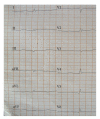Inferior ST-Elevation Myocardial Infarction Associated with Takotsubo Cardiomyopathy
- PMID: 20811565
- PMCID: PMC2929624
- DOI: 10.1155/2010/467867
Inferior ST-Elevation Myocardial Infarction Associated with Takotsubo Cardiomyopathy
Abstract
Takotsubo cardiomyopathy (TCM) is usually characterized by transient left ventricular apical ballooning. Due to the clinical symptoms which include chest pain, electrocardiographic changes, and elevated myocardial markers, Takotsubo cardiomyopathy is frequently mimicking ST-elevation myocardial infarction in the absence of a significant coronary artery disease. Otherwise an acute occlusion of the left anterior descending coronary artery can produce a typical Takotsubo contraction pattern. ST-elevation myocardial infarction (STEMI) is frequently associated with emotional stress, but to date no cases of STEMI triggering TCM have been reported. We describe a case of a female patient with inferior ST-elevation myocardial infarction complicated by TCM.
Figures





References
-
- Dote K, Sato H, Tateishi H, Uchida T, Ishihara M. Myocardial stunning due to simultaneous multivessel coronary spasms: a review of 5 cases. Journal of Cardiology. 1991;21(2):203–214. - PubMed
-
- Gianni M, Dentali F, Grandi AM, Sumner G, Hiralal R, Lonn E. Apical ballooning syndrome or takotsubo cardiomyopathy: a systematic review. European Heart Journal. 2006;27(13):1523–1529. - PubMed
-
- Koeth O, Mark B, Kilkowski A, et al. Clinical, angiographic and cardiovascular magnetic resonance findings in consecutive patients with Takotsubo cardiomyopathy. Clinical Research in Cardiology. 2008;97(9):623–627. - PubMed
-
- Abe Y, Kondo M, Matsuoka R, Araki M, Dohyama K, Tanio H. Assessment of clinical features in transient left ventricular apical ballooning. Journal of the American College of Cardiology. 2003;41(5):737–742. - PubMed
Publication types
LinkOut - more resources
Full Text Sources

